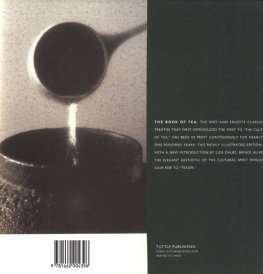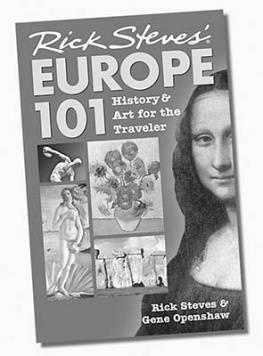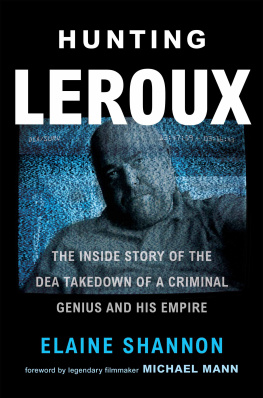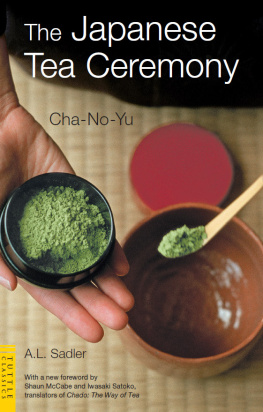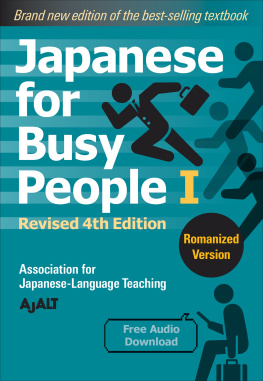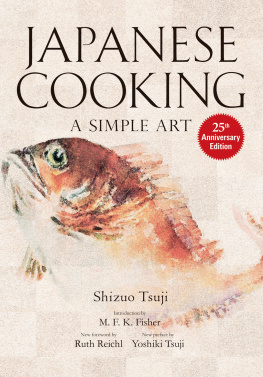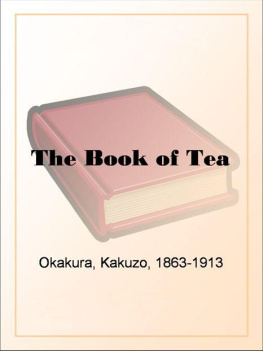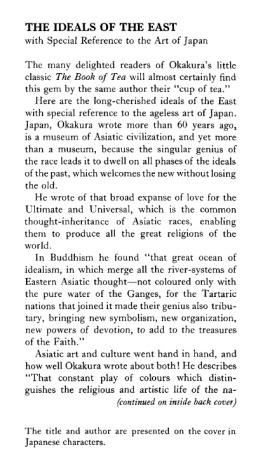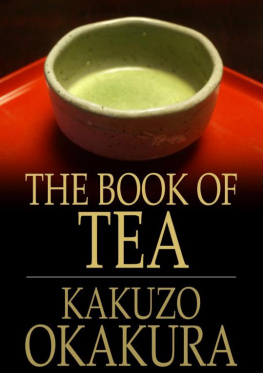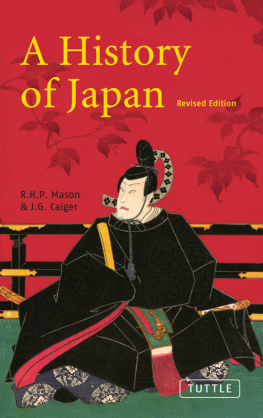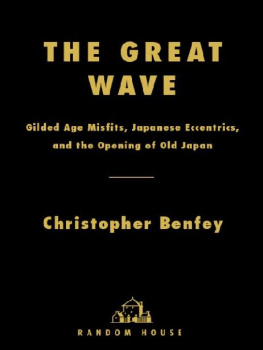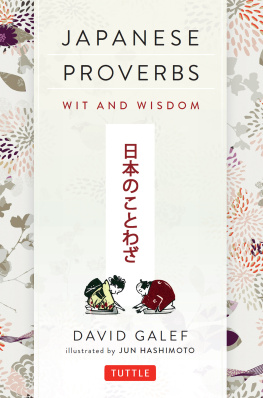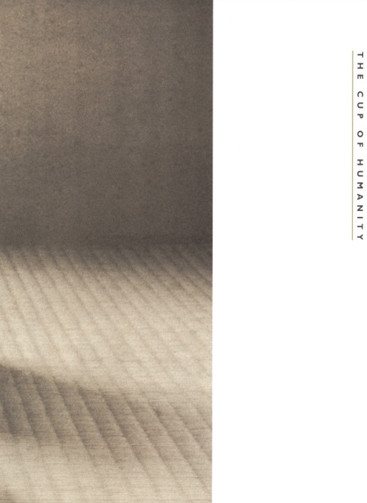


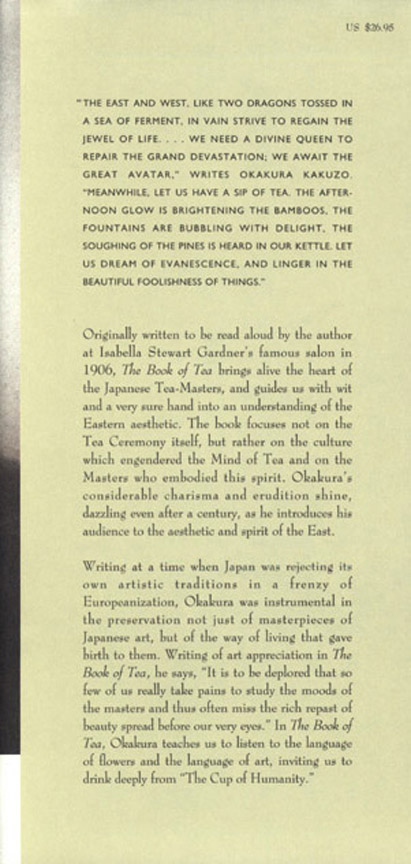
The Book of Tea
WAS ART DIRECTED & DESIGNED BY
MICHELE WETHERBEE
IN PETALUMA, CALIFORNIA.
TYPE WAS COMPOSED WITH QUARKXPRESS
SOFTWARE USING GILL SANS AND BERNHARDT MODERN.
PHOTOGRAPHIC STYLING, CAPTIONS,
MU CALLIGRAPHY & BAMBOO INK DRAWING ARE BY
DAVID FURUKAWA-CHEN
THE PHOTOGRAPHS
WERE TAKEN ON NIKON F3 FILM BY
DANIEL PROCTOR
IN SAN FRANCISCO. CALIFORNIA.
DIGITAL ENHANCEMENT BY FATCAT DIGITAL
THE PHOTOGRAPHS ARE PRINTED AS QUADTONES.
THE BOOK WAS PRINTED AND BOUND BY
PALACE PRESS INTERNATIONAL,
IN CHINA.
TEA BEGAN AS A MEDICINE AND GREW INTO A beverage. In China, in the eighth century, it entered the realm of poetry as one of the polite amusements. The fifteenth century saw japan ennoble it into a religion of aestheticismTeaism. Teaism is a cult founded on the adoration of the beautiful among the sordid facts of everyday existence. It inculcates purity and harmony, the mystery of mutual charity, the romanticism of the social order. It is essentially a worship of the Imperfect, as it is a tender attempt to accomplish something possible in this impossible thing we know as life.
The Philosophy of Tea is not mere aestheticism in the ordinary acceptance of the term, for it expresses conjointly with ethics and religion our whole point of view about man and nature. It is hygiene, for it enforces cleanliness; it is economics, for it shows comfort in simplicity rather than in the complex and costly; it is moral geometry, inasmuch as it defines our sense of proportion to the universe. It represents the true spirit of Eastern democracy by making all its votaries aristocrats in taste.
The long isolation of Japan from the rest of the world, so conducive to introspection, has been highly favourable to the development of Teaism. Our home and habits, costume and cuisine, porcelain, lacquer, paintingour very literatureall have been subject to its influence. No student of Japanese culture could ever ignore its presence. It has permeated the elegance of noble boudoirs, and entered the abode of the humble. Our peasants have learned to arrange flowers, our meanest labourer to offer his salutation to the rocks and waters. In our common parlance we speak of the man "with no tea" in him, when he is insusceptible to the serio-comic interests of the personal drama. Again we stigmatise the untamed aesthete who, regardless of the mundane tragedy, runs riot in the springtide of emancipated emotions, as one "with too much tea" in him.
The outsider may indeed wonder at this seeming much ado about nothing. What a tempest in a tea-cup! he will say. But when we consider how small after all the cup of human enjoyment is, how soon overflowed with tears, how easily drained to the dregs in our quenchless thirst for infinity, we shall not blame ourselves for making so much of the tea-cup. Mankind has done worse. In the worship of Bacchus, we have sacrificed too freely; and we have even transfigured the gory image of Mars. Why not consecrate ourselves to the queen of the Camelias, and revel in the warm stream of sympathy that flows from her altar? In the liquid amber within the ivory-porcelain, the initiated may touch the sweet reticence of Confucius, the piquancy of Laotse, and the ethereal aroma of Sakyamuni himself.
Those who cannot feel the littleness of great things in themselves are apt to overlook the greatness of little things in others. The average Westerner, in his sleek complacency, will see in the tea ceremony but another instance of the thousand and one oddities which constitute the quaintness and childishness of the East to him. He was wont to regard Japan as barbarous while she indulged in the gentle arts of peace: he calls her civilised since she began to commit wholesale slaughter on Manchurian battlefields. Much comment has been given lately to the Code of the Samurai,the Art of Death which makes our soldiers exult in self-sacrifice; but scarcely any attention has been drawn to Teaism, which represents so much of our Art of Life. Fain would we remain barbarians, if our claim to civilisation were to be based on the gruesome glory of war. Fain would we await the time when due respect shall be paid to our art and ideals.
Wh en will the West understand, or try to understand, the East? We Asiatics are often appalled by the curious web of facts and fancies which has been woven concerning us. We are pictured as living on the perfume of the lotus, if not on mice and cockroaches. It is either impotent fanaticism or else abject voluptuousness. Indian spirituality has been derided as ignorance, Chinese sobriety as stupidity, Japanese patriotism as the result of fatalism. It has been said that we are less sensible to pain and wounds on account of the callousness of our nervous organisation!
Why not amuse yourselves at our expense? Asia returns the compliment. There wouId be further rood for merriment if you were to know all that we have imagined and written about you. All the glamour of the perspective is there, all the unconscious homage of wonder, all the silent resentment of the new and undefined. You have been loaded with virtues too refined to be envied, and accused of crimes too picturesque to be condemned. Our writers in the pastthe wise men who knewinformed us that you had bushy tails somewhere hidden in your garments, and often dined off a fricassee of newborn babes! Nay, we had something worse against you: we used to think you the most impracticable people on the earth, for you were said to preach what you never practised.
Such misconceptions are fast vanishing amongst us. Commerce has forced the European tongues on many an Eastern port. Asiatic youths are flocking to Western colleges for the equipment of modern education. Our insight does not penetrate your culture deeply, but at least we are willing to learn. Some of my compatriots have adopted too much of your customs and too much of your etiquette, in the delusion that the acquisition of stiff collars and tall silk hats comprised the attainment of your civilisation. Pathetic and deplorable as such affectations are, they evince our willingness to approach the West on our knees. Unfortunately the Western attitude is unfavourable to the understanding of the East. The Christian missionary goes to impart, but not to receive. Your information is based on the meagre translations of our immense literature, if not on the unreliable anecdotes of passing travellers. It is rarely that the chivalrous pen of a Lafcadio Hearn or that of the author of "The Web of Indian Life" enlivens the Oriental darkness with the torch of our own sentiments.
Perhaps I betray my own ignorance of the Tea Cult by being so outspoken. Its very spirit of politeness exacts that you say what you are expected to say, and no more. But I am not to he a polite Teaist. So much harm has been done already by the mutual misunderstanding of the New World and the Old, that one need not apologise for contributing his tithe to the furtherance of a better understanding. The beginning of the twentieth century would have been spared the spectacle of sanguinary warfare if Russia had condescended to know Japan better. What dire consequences to humanity lie in the contemptuous ignoring of Eastern problems! European imperialism, which does not disdain to raise the absurd cry of the Yellow Peril, fails to realise that Asia may also awaken to the cruel sense of the White Disaster. You may laugh at us for having "too muck tea," but may we not suspect that you of the West have "no tea" in your constitution?

